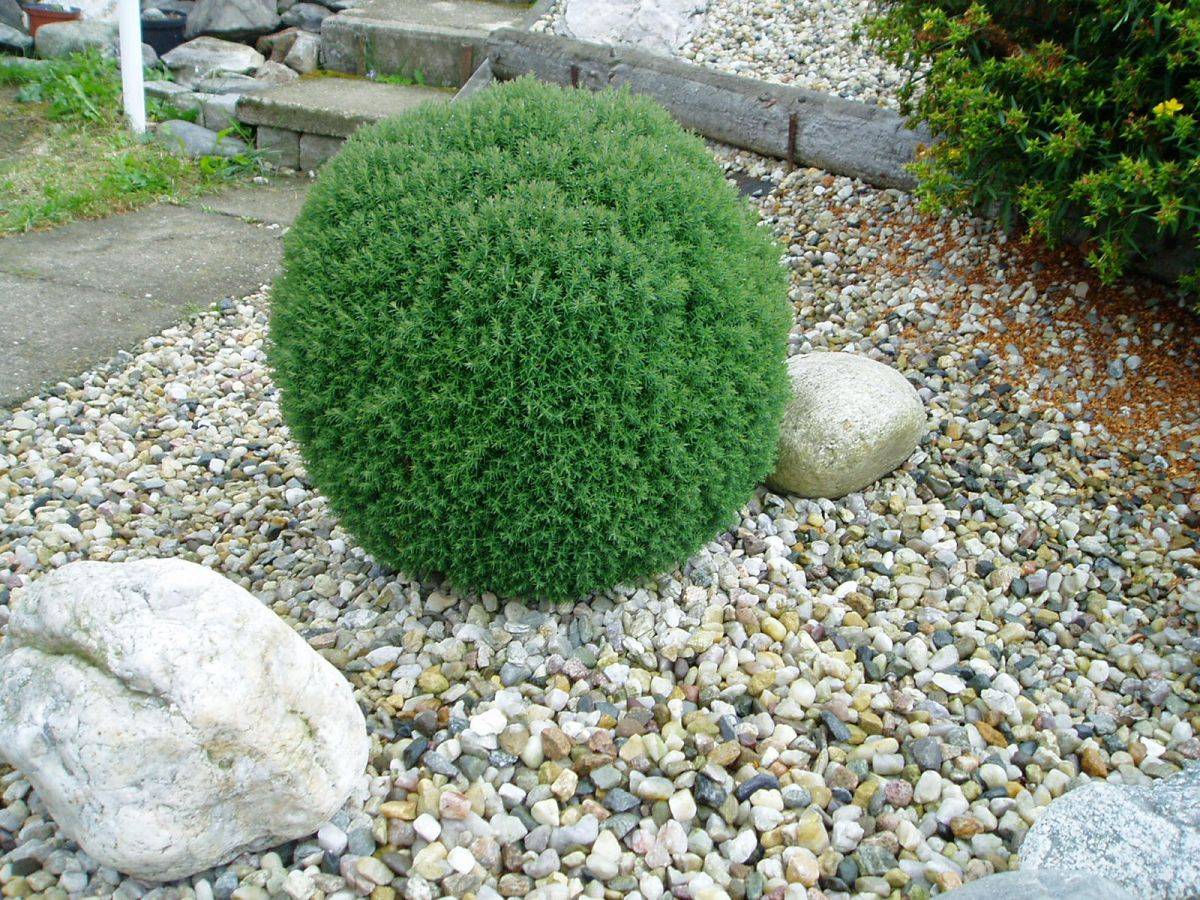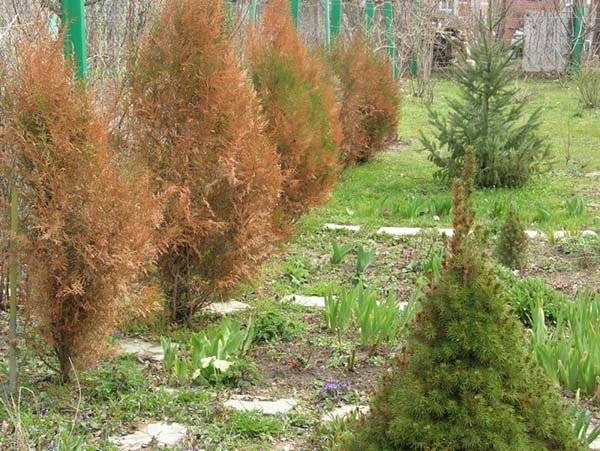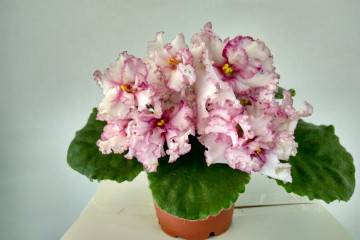Thuja Teddy (Teddy) western - description of the variety
Content:
Thuja western Teddy is a small evergreen dwarf plant. It is very popular in landscape design. Due to its small size, it decorates flower beds, alleys, rock gardens. Thuja is unpretentious in care and adapted to growing in the middle climatic zone.
Description of Western Thuja Teddy (Teddy)
Thuja western Teddy belongs to the Cypress family. Thanks to the selection of the Cobalt variety in 1950, the world saw this small and decorative tree. Thuja is considered the birthplace of North America.
Dimensions (edit)
Teddy is a small spherical coniferous plant. On average, the bush grows up to 0.5 m. The color of the crown changes depending on the season. In spring it turns green, in autumn it takes on a bronze tint. The leaves are acicular green with an emerald tint. They are soft to the touch. At the top of the tree there are small brown cones that are covered with scales. The main role of the scales is to protect the seeds.
How fast does Thuja Teddy grow
Thuja globular Teddy grows slowly, from 2 to 7 cm per year. For 10 years, it can grow up to 30 cm. It grows in width to 40-45 cm. A distinctive feature of the western thuja is that it does not need formative pruning. After a couple of years, the plant independently takes on a thick and dense form.
Planting and caring for thuja Teddy
Thuja Teddy is a frost-resistant variety. It tolerates temperatures as low as -35 ° C. Suitable for growing in the Moscow region, Bryansk, Leningrad, Voronezh, Saratov and other regions.
Before planting a plant in open ground, you need to choose a place. It should be sunny and slightly shaded. Also, the site must be protected from drafts and strong gusts of wind. The plant can grow in any soil, it adapts especially well in soddy, loose and moderately moist soil. In the area on which the Teddy thuja will grow, moisture should not stagnate. It is advisable to plant in an area with a slight slope.
How to plant
An important role in the cultivation of the bush is played by the choice of quality seedlings. They are sold with closed (in containers) or open root systems. The second option is cheaper. When buying, you should pay attention to the needles, they should be green and shiny.
Planting time depends on the root system:
- bushes with open roots are planted in early spring or autumn;
- bushes with closed roots are planted in April or October.
Step-by-step instructions for planting Tui:
- Site preparation. The place where the plant will be planted must be dug up and fertilized. It can be organic matter (manure, humus, compost, wood ash) or mineral complexes.
- Pit preparation. A recess is dug on the site, which should be larger than the container. A drainage layer of about 20 cm (expanded clay or pebbles) is poured onto the bottom.
- Fertilization. Fertilizers are placed on the drainage layer, which consist of: peat, turf and sand. All components are mixed in equal proportions. If the soil is poor in minerals, then potassium, nitrogen and phosphorus are added to it.
- Landing. A seedling is placed in the pit, which is sprinkled with earth.
- Watering.After planting, the soil is moistened and mulch (dry grass or sawdust) is sprinkled on top.
Watering mode
After planting for three weeks, the bushes must be watered regularly. The main thing is not to overdo it, since moisture in large quantities is harmful to the plant. After the thuja has taken root, watering is reduced to once a week.
An adult plant takes two buckets of water. In summer, the tree should be watered more often with warm water. Cold reduces the aromatic properties of the plant. It is necessary to water the bushes in the morning or in the evening after sunset. After each watering, the soil under the bush must be loosened regularly.
Top dressing
For a tree to develop and grow, it needs feeding. In the first year of life, a young plant is fed twice. The first is at the time of landing, the second is after six months. Then Teddy is fertilized with mineral complexes once a year. Fertilizers are applied in April or May. For hardy and evergreen plants, nutrisol is often used. After feeding, loosening and the introduction of peat and compost are necessary.
Features of summer care
With the onset of summer, when solar activity is high, at noon the bushes must be shaded, ensure regular watering, and also loosen the soil. In summer, moisture evaporates faster, it is recommended to mulch the soil around the tree. To do this, you can use sawdust, bark, peat. The layer thickness must be at least 7 cm.
Preparing Tui Teddy for winter
Thuja western is frost-resistant and does not need shelter. The bushes are insulated only in the first year after planting. For this, you can use agrofibre, hay, foam. To prevent the branches from breaking under the weight of the snow, they are tied up.
You can protect plants from large snow cover by using a frame shelter. It is a metal mesh with cells.
Reproduction of thuja Teddy
Bushes are propagated in two ways - by seed or cuttings. The first method is laborious; you will have to make a lot of effort to grow home thuja.
You will need fresh seeds for growing. You can collect them in the fall or purchase them in a specialized store. Before sowing, the seeds are placed in the freezer for three months. Sow them in a container with sod soil, after placing them in a weak solution of potassium permanganate. It is deepened to a depth of 5 mm, sprinkled with earth on top. After planting, future bushes are moistened with a spray bottle. The container must be covered with foil, opened once a day.
Propagation by cuttings
Growing from cuttings is the easiest way to propagate. Thanks to him, the varietal characteristics of thuja are preserved.
For cuttings, take lignified two-year-old shoots with a length of 20 to 30 cm. Harvesting of planting material occurs in the fall. The lower part of the cutting is cleaned of needles. Then he is soaked in a growth stimulator, after which he is planted in a container with soil. The box with the plant is placed in a room with a temperature of at least 22 ° C. The soil must be regularly moistened. After the cutting has taken root, it is planted in a larger pot. In the spring, he is sent to the open ground.
Why does thuja Teddy turn yellow
Teddy is a long-term houseplant that is easy to care for. But it so happens that the leaves of the needles turn yellow and dry. The causes of drying are varied, from natural to infections and fungi.
Natural causes include:
- loss of chlorophyll.In the fall, thuja is experiencing a lack of minerals. The needles begin to turn yellow and fall off. In their place, new, green leaves appear;
- reaction to a sharp change in temperature. Temperature jumps are bad for the plant;
- lack of moisture. With insufficient soil moisture, the bush begins to dry. You can correct the situation with abundant watering;
- excess moisture. With a very moist soil, rotting begins in the roots. As a result, yellow needles;
- burn. Ultraviolet rays burn the foliage of the tree. At noon, when the sun is too active, the bushes should be shaded;
- lack of nutrients in the soil. If the soil lacks nutrients, namely iron, the needles turn yellow. Lack of phosphorus leads to foliage falling.
In addition to natural causes, the yellowing of thuja is affected by the presence of one of the diseases or pests:
- snow mold. You can find it after the snow melts. The needles are covered with a gray bloom, then they turn yellow and fall off;
- spider mite. Teddy attacks in hot summer, insect larvae are especially dangerous. It is they who infect the needles;
- tinder fungus. The hard fungus attaches to the bark and feeds on the sap. If the fungus is too large, the thuja may die.
When yellow needles appear, it is necessary to carefully examine the bush for the presence of fungi and parasites. Fungicides will help against ailments, and insecticides will help parasites.
Thuja western has excellent characteristics. It does not require special care; even a novice gardener can grow it at home. Thanks to its decorative appearance, it will become a real decoration of the garden.



















